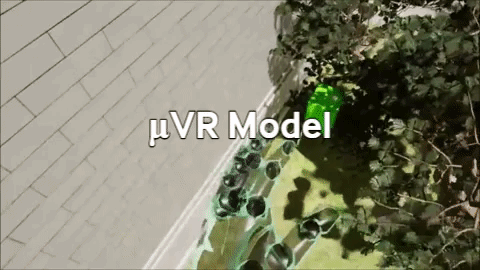The μVR model (B. Fanini, CNR ISPC) combines real-walking techniques and an adaptive, multi-scale gameplay to craft immersive VR (HMD) recontextualization applications and 3D puzzles. The model (and applications created on top of it) aims to remove/minimize motion sickness while fully exploiting the physical tracked area available, combining game state and world scale.
You can find the published article (2018) on Multimodal Technologies and Interaction journal or here (direct PDF on MTI).
Reference (bibtex):
@article{fanini2018uVR,
title={A Novel Immersive VR Game Model for Recontextualization in Virtual Environments: The $\mu$VR Model},
journal={Multimodal Technologies and Interaction},
author={Bruno Fanini and Alfonsina Pagano and Daniele Ferdani},
doi={10.3390/mti2020020},
url={http://doi.org/10.3390/mti2020020},
year={2018}
}The very first goal of the μVR Model is to completely remove artificial locomotion techniques (e.g., teleport) by instead exploiting the physical tracked area and real walking techniques combined with game state and world scale. Given a collection of k items
{ I1, I2, I3, … Ik }
The model guarantees two major properties, at any given time:
- Each unsolved item is reachable (i.e.: relies inside the physical area)
- Each unsolved item is solvable by user interaction (inside the physical area)
The global unsolved volume V is defined as the additive expansion of unsolved volumes Vi for each single item in the collection. The μ operator is defined as
μ( s ) → s’
Its role is to compute a specific set of VR parameters in order to satisfy the properties (1) and (2).

How to create a μVR game level
Following video is a recorded Unreal Editor session using the μVR plugin (C++ and blueprints) to easily arrange and create a μVR level.
You can find the open-source (GPL) plugin for Unreal Engine 4 here:
